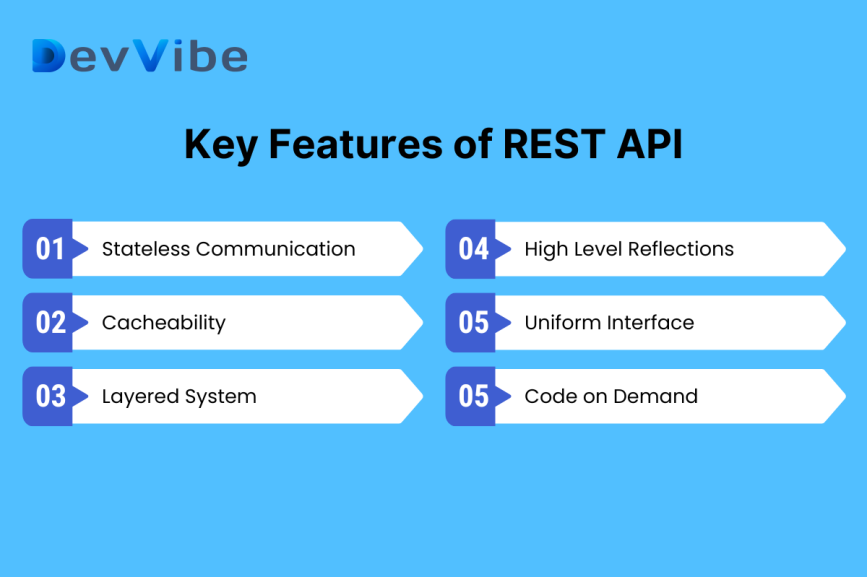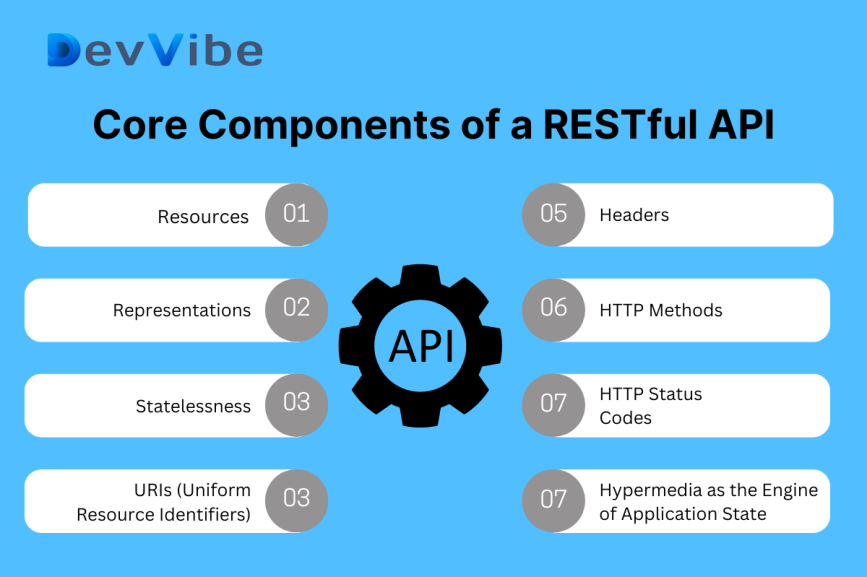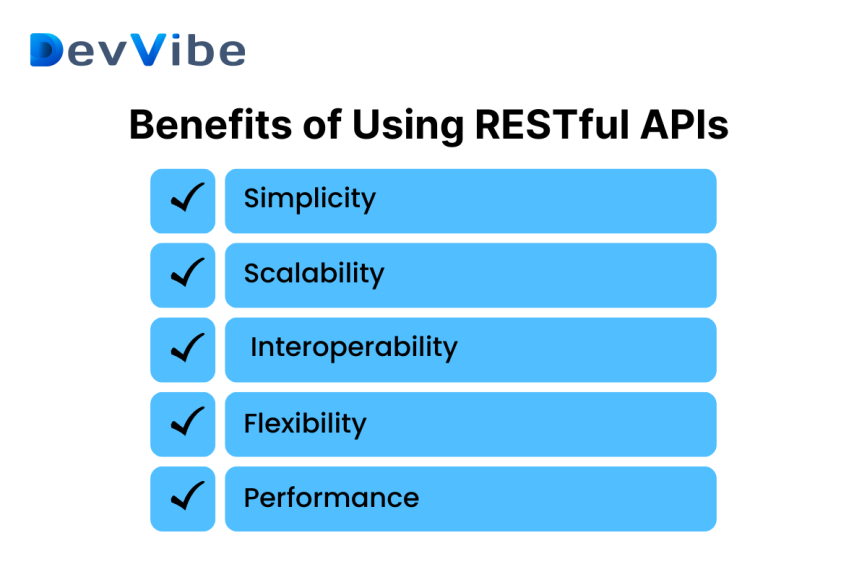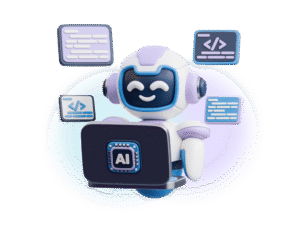Over the years, the RESTful API has seen substantial updates and improvements, leading to different versions like RestFul, RestEasy, and Restlet. Both RESTful API and REST API a common purpose is building web applications. These APIs allow servers to be accessed through the HTTP protocol, which forms the backbone of communication between clients and servers. They operate on a traditional client-server model, which means minimal server logic is required. Developers typically build RESTful APIs on top of HTTP due to its simplicity and widespread use.
In today’s tech landscape, where microservices and distributed architectures are becoming the norm, understanding the nuances between REST API vs RESTful API is crucial. While these terms are often used interchangeably, they have subtle differences that impact how they are implemented and used in software development.
In this detailed guide, we will explore the differences between REST API and RESTful API, their core principles, components, and how they are used in building modern web applications.
REST API vs RESTful API: Key Difference
Both REST API and RESTful API are designed to facilitate communication between a client and a server, but they differ slightly differently in how they handle and structure this communication.
REST API
A REST API (Representational State Transfer API) utilizes the HTTP protocol for server interactions. It allows you to access and manipulate resources on a server using standard HTTP methods such as GET, POST, PUT, and DELETE.
- Data Fetching: When making a request to a REST API, you typically specify a URL that identifies the resource you want to access. The response from the server is often in a format like JSON or XML, which includes the requested data.
- Data Structure: The structure of the response data can vary based on the implementation. Different endpoints may return data in different formats or structures, depending on how the API is designed.
RESTful API
A RESTful API is a specific implementation of a REST API that strictly adheres to the principles of REST architecture. It also uses HTTP methods for communication but follows additional constraints to ensure consistency and scalability.
- Resource Identification: In a RESTful API, every resource is identified by a unique URI (Uniform Resource Identifier). This means that each resource can be accessed via a specific URL, and the data returned follows a consistent structure based on the resource.
- Uniform Interface: RESTful APIs maintain a uniform interface, meaning that the interaction with resources is standardized. This uniformity makes it easier to predict the behavior of the API and ensures that the same types of responses are returned for similar requests.
What is REST API?
A REST API (Representational State Transfer API) is a software architectural style that defines a set of constraints to be used when creating web services. These web services are lightweight, maintainable, and scalable, making REST APIs ideal for microservice architectures. REST APIs are designed to take advantage of existing protocols. While REST can be used over nearly any protocol, it usually takes advantage of HTTP when used for web APIs.
Key Features of REST API

REST APIs are characterized by their use of standard HTTP methods and status codes, resource-based endpoints, and statelessness. Here are the main features that define a REST API:
- Resource-Based Architecture: REST APIs manipulate resources (data entities) via URI (Uniform Resource Identifier) endpoints. Each resource is identified by a unique URI, allowing clients to access or manipulate the resource directly. For example, https://api.example.com/users/1234 accesses the user resource with ID 1234.
- Stateless Communication: REST APIs are stateless, meaning that each request from the client to the server must contain all the information needed to understand and process the request. The server does not store any client session data, making interactions between the client and server independent and isolated.
- Cacheability: REST APIs can specify whether responses are cacheable or not. This enables clients to cache responses, reducing repeated requests to the server and improving overall performance.
- Uniform Interface: REST APIs use standard HTTP methods such as GET, POST, PUT, DELETE, and PATCH to perform CRUD (Create, Read, Update, Delete) operations on resources. This uniformity simplifies the interaction between clients and servers, as the same methods can be applied across different resources.
- Layered System: REST APIs are designed with a layered architecture, where clients cannot tell whether they are connected directly to the end server or through an intermediary like a proxy, load balancer, or cache. This abstraction allows for better scalability and management of network traffic.
- Code on Demand (Optional): While not commonly used, REST allows for code on demand, where the server can send executable code (such as JavaScript) to the client, which can then be executed within the client’s context. This enables more dynamic and interactive applications.
Why REST API is Popular in Modern Software Development
The popularity of REST APIs in modern software development stems from their simplicity, scalability, and flexibility. REST APIs allow developers to build applications that are modular and can easily integrate with other services. The stateless nature of REST APIs makes them highly scalable, as the server does not need to store any information about the client between requests. Additionally, the use of standard HTTP methods and status codes makes REST APIs easy to implement and debug.
Furthermore, REST APIs are language-agnostic, meaning they can be implemented in any programming language that supports HTTP. This makes them a versatile choice for developing web services, as they can be used across different platforms and technologies.
What is a RESTful API?
A RESTful API is an implementation of the REST architectural style, adhering strictly to the principles and constraints of REST. It is a type of web service that provides a set of rules for how clients can communicate with servers using HTTP. RESTful APIs are designed to take full advantage of the HTTP protocol, making them efficient and easy to use.
The Core Components of a RESTful API

RESTful APIs consist of several key components that define how they operate and interact with clients. These components include:
- Resources: In a RESTful API, everything is considered a resource. Resources are the fundamental units of data that the API exposes to clients. Examples of resources include users, orders, products, and any other data entity that the API manages.
- URIs (Uniform Resource Identifiers): Each resource in a RESTful API is identified by a unique URI. URIs serve as the address for accessing resources, allowing clients to interact with specific resources via HTTP requests. For example, https://api.example.com/customers/1234 identifies the customer resource with ID 1234.
- HTTP Methods: RESTful APIs use standard HTTP methods to perform operations on resources. These methods include:
- GET: Retrieves a representation of a resource.
- POST: Creates a new resource.
- PUT: Updates an existing resource.
- PATCH: Partially updates an existing resource.
- DELETE: Deletes a resource.
- Representations: Resources in a RESTful API are represented in various formats, such as JSON (JavaScript Object Notation), XML (Extensible Markup Language), or HTML. Clients can specify their preferred format in the HTTP request using the Accept header.
- HTTP Status Codes: RESTful APIs use standard HTTP status codes to indicate the outcome of a request. Common status codes include:
- 200 OK: The request was successful.
- 201 Created: A new resource was successfully created.
- 204 No Content: The request was successful, but there is no representation to return.
- 400 Bad Request: The request was invalid or cannot be processed.
- 404 Not Found: The requested resource could not be found.
- 500 Internal Server Error: The server encountered an unexpected condition.
- Headers: HTTP headers provide metadata about the request or response, such as content type, authorization credentials, cache settings, and more. Headers play a crucial role in how clients and servers communicate within a RESTful API.
- Hypermedia as the Engine of Application State (HATEOAS): A key principle of REST is that clients interact with the API entirely through hypermedia provided dynamically by application servers. This means that responses from the server include links (hypermedia) to related resources or actions that the client can take next.
- Statelessness: Like REST APIs, RESTful APIs are stateless, meaning that the server does not store any session information between requests. Each request from the client must contain all necessary information to be processed independently.
Benefits of Using RESTful APIs

RESTful APIs offer several benefits that make them a popular choice for developers:
- Simplicity: RESTful APIs are simple to design, implement, and use. The use of standard HTTP methods and status codes simplifies the interaction between clients and servers.
- Scalability: The stateless nature of RESTful APIs allows them to scale easily. Because the server does not store any session information, it can handle multiple requests from different clients simultaneously without any risk of state conflicts.
- Interoperability: RESTful APIs are language-agnostic, meaning they can be implemented and consumed by applications written in different programming languages. This makes them a versatile choice for building APIs that need to interact with various systems and platforms.
- Flexibility: RESTful APIs are flexible and can be used to build a wide range of applications, from simple web services to complex, distributed systems. The use of hypermedia (HATEOAS) also allows clients to discover and navigate the API dynamically, making it easier to build adaptive and responsive applications.
- Performance: RESTful APIs are designed to be lightweight and efficient, making them well-suited for high-performance applications. The use of caching further enhances performance by reducing the need for repeated requests to the server.
REST API vs RESTful API: Which One is Best for Software Application Development?
When deciding between REST API and RESTful API for software application development, it’s essential to consider the specific needs and requirements of your project. Both approaches have their strengths and weaknesses, and the choice between them depends on factors such as scalability, flexibility, and ease of use.
Similarities and Differences
While REST API and RESTful API share many similarities, they also have some key differences that set them apart. Understanding these differences is crucial for making an informed decision:
- Design Philosophy: REST API focuses purely on functionality and endpoints, while RESTful API follows the constraints of the REST architectural style, ensuring that all interactions are stateless, resource-based, and uniform.
- Resources: In RESTful APIs, endpoints represent resources that can be manipulated, while in REST APIs, endpoints may not always represent resources in a consistent manner.
- HTTP Methods: RESTful APIs use HTTP methods like GET, POST, PUT, and DELETE consistently and correctly, adhering to the REST principles. REST APIs, on the other hand, may use these methods inconsistently.
- Statelessness: Both REST API and RESTful API are stateless, but RESTful APIs explicitly enforce this principle by ensuring that no session state is stored on the server between requests.
- Cacheability: RESTful APIs explicitly mark whether responses are cacheable, while REST APIs may not always do so, leading to potential inefficiencies in caching.
- Uniform Interface: RESTful APIs provide a uniform interface for interacting with resources, while REST APIs may vary in how they handle different endpoints.
- Client-Server Separation: RESTful APIs enforce a clear separation between client and server code, whereas REST APIs may mix client and server logic.
- Layered System: RESTful APIs adhere to a layered architecture, ensuring that intermediaries like proxies and load balancers can be used effectively. REST APIs may not always follow this principle.
When to Use REST API
REST APIs are a good choice when you need a simple, straightforward way to interact with a server and perform CRUD operations on resources. They are ideal for projects where the primary focus is on functionality and where the constraints of the REST architectural style are not a priority.
When to Use RESTful API
RESTful APIs are the preferred choice when you need a scalable, flexible, and maintainable solution that adheres to the principles of REST. They are well-suited for complex, distributed systems where consistency, uniformity, and statelessness are essential. RESTful APIs are also a good choice when you need to build an API that is language-agnostic and can be easily integrated with other systems.
REST API vs RESTful API – Technical Differences
To better understand the technical differences between REST API vs RESTful API, let’s compare them side by side:
| Feature | REST API | RESTful API |
| Design Philosophy | Focuses on functionality and endpoints | Follows the constraints of REST architecture |
| Resources | Endpoints may not represent resources | Endpoints represent resources that can be manipulated |
| HTTP Methods | May use HTTP methods inconsistently | Consistently uses HTTP methods like GET, POST, PUT, DELETE |
| Statelessness | Responses may not always be cacheable | Stateless between requests |
| Cacheable | Responses may not always be cacheable | Responses explicitly mark cacheability |
| Uniform Interface | Interface may vary between endpoints | Uniform interface provided by resources and representations |
| Client-Server Separation | May mix client and server code | Clear separation between client and server |
| Layered System | May bypass intermediate servers | Explicitly layered architecture |
| Code on Demand (Optional) | May not allow downloadable code | May allow code download for client execution |
Save Time and Resources with Custom-Built Web Apps
Are you tired of piecing together disjointed systems that don’t work well together? Custom-built web applications can streamline your workflows and improve your efficiency. By leveraging the power of RESTful APIs, you can create web apps that are tailored to your unique needs, saving you time and resources.
At DevVibe, we specialize in building fully customized web applications that integrate seamlessly with your existing systems. Our expert developers can help you design and implement a RESTful API that meets your specific requirements, ensuring that your web app is scalable, maintainable, and easy to use. You can read more details about web application vs desktop application in our website blogs.
REST API vs RESTful API: Final Words
As the tech landscape evolves, more companies are moving toward using APIs because they are both user-friendly and developer-friendly. While REST API and RESTful API share many similarities, understanding the key differences between them is crucial for making informed decisions about your software development projects.
REST API is a versatile and widely used method for developing web applications, while RESTful API offers a more structured and scalable approach that adheres strictly to the principles of REST. Both have their place in modern software development, and the choice between them depends on your specific needs and project requirements.
Whether you’re building a simple web service or a complex, distributed system, understanding the nuances of REST API vs RESTful API will help you choose the right approach for your application.
Hire the Best Web Application Development Company
If you’re ready to elevate your web application, consider partnering with devvibe a leading software company specializing in game development, bespoke software, and high-quality mobile application development. With a focus on integrating AI with Flutter and .NET framework development, we can help you build the custom web apps you need to succeed.





